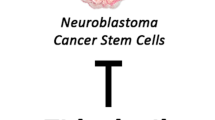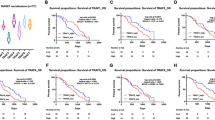Abstract
Glioblastoma is the most prevalent and highly malignant brain tumor that continues to defy current treatment strategies. This investigation used all-trans retinoic acid (ATRA) and taxol (TXL) as a combination therapy for controlling the growth of human glioblastoma T98G xenografted in athymic nude mice. Histopathological examination revealed that ATRA induced differentiation and combination of ATRA and TXL caused more apoptosis than either treatment alone. Combination therapy decreased expression of telomerase, nuclear factor kappa B (NFκВ), and inhibitor-of-apoptosis proteins (IAPs) indicating suppression of survival factors while upregulated Smac/Diablo. Combination therapy also changed expression of Bax and Bcl-2 proteins leading to increased Bax:Bcl-2 ratio, mitochondrial release of cytochrome c and apoptosis-inducing factor (AIF), and activation of caspase-9. Increased activities of calpain and caspase-3 degraded 270 kD α-spectrin at the specific sites to generate 145 kD spectrin breakdown product (SBDP) and 120 kD SBDP, respectively. Further, increased activity of caspase-3 cleaved inhibitor-of-caspase-activated DNase (ICAD). In situ double immunofluorescent labelings showed overexpression of calpain, caspase-12, caspase-3, and AIF during apoptosis, suggesting involvement of both caspase-dependent and caspase-independent pathways for apoptosis. Our investigation revealed that treatment of glioblastoma T98G xenografts with the combination of ATRA and TXL induced differentiation and multiple molecular mechanisms for apoptosis.






Similar content being viewed by others
Abbreviations
- AIF:
-
Apoptosis inducing factor
- ATRA:
-
All-trans retinoic acid
- BIRC-2:
-
Baculovirus inhibitor-of-apoptosis repeat containing-2
- BIRC-3:
-
Baculovirus inhibitor-of-apoptosis repeat containing-3
- BIRC-5:
-
Baculovirus inhibitor-of-apoptosis repeat containing-5
- CAD:
-
Caspase-3-activated DNase
- c-IAP1:
-
Cellular inhibitor-of-apoptosis protein 1
- c-IAP2:
-
Cellular inhibitor-of-apoptosis protein 2
- DIF:
-
Double immunofluorescent
- EB:
-
Equilibration buffer
- ER:
-
Endoplasmic reticulum
- FITC:
-
Fluorescein isothiocyanate
- hTERT:
-
Human telomerase reverse transcriptase
- IAP:
-
Inhibitor-of-apoptosis protein
- ICAD:
-
Inhibitor of caspase-activated DNase
- NFκВ:
-
Nuclear factor kappa B
- TUNEL:
-
Terminal deoxynucleotidyl transferase-mediated dUTP nick-end labeling
- TXL:
-
Taxol
- SBDP:
-
Spectrin breakdown product
- SIF:
-
Single immunofluorescent
- Smac/Diablo:
-
Second mitochondrial activator of caspases/Direct IAP Binding protein with Low pI
References
Greenlee RT, Murray T, Bolden S, Wingo PA (2000) Cancer statistics, 2000. CA Cancer J Clin 50(1):7–33
Teicher BA, Menon K, Alvarez E, Galbreath E, Shih C, Faul M (2001) Antiangiogenic and antitumor effects of a protein kinase Cβ inhibitor in human T98G glioblastoma multiforme xenografts. Clin Cancer Res 7(3):634–640
Phuong LK, Allen C, Peng KW et al (2003) Use of a vaccine strain of measles virus genetically engineered to produce carcinoembryonic antigen as a novel therapeutic agent against glioblastoma multiforme. Cancer Res 63(10):2462–2469
Nagane M, Levitzki A, Gazit A, Cavenee WK, Huang HJ (1998) Drug resistance of human glioblastoma cells conferred by a tumor-specific mutant epidermal growth factor receptor through modulation of Bcl-xL and caspase-3-like proteases. Proc Natl Acad Sci USA 95(10):5724–5729
Ashkenazi A, Dixit VM (1998) Death receptors: signaling and modulation. Science 281(5381):1305–1308
Green DR, Reed JC (1998) Mitochondria and apoptosis. Science 281(5381):1309–1312
Pennarun G, Granotier C, Gauthier LR et al (2005) Apoptosis related to telomere instability and cell cycle alterations in human glioma cells treated by new highly selective G-quadruplex ligands. Oncogene 24(18):2917–2928
Sun J, Huang H, Zhu Y et al (2005) The expression of telomeric proteins and their probable regulation of telomerase during the differentiation of all-trans-retinoic acid-responsive and -resistant acute promyelocytic leukemia cells. Int J Hematol 82(3):215–223
Haque A, Das A, Hajiaghamohseni LM, Younger A, Banik NL, Ray SK (2007) Induction of apoptosis and immune response by all-trans retinoic acid plus interferon-gamma in human malignant glioblastoma T98G and U87MG cells. Cancer Immunol Immunother 56(5):615–625
Nehme A, Varadarajan P, Sellakumar G et al (2001) Modulation of docetaxel-induced apoptosis and cell cycle arrest by all-trans retinoic acid in prostate cancer cells. Br J Cancer 84(11):1571–1576
Merino R, Hurle JM (2003) The molecular basis of retinoid action in tumors. Trends Mol Med 9(12):509–511
Horwitz SB (1992) Mechanism of action of taxol. Trends Pharmacol Sci 13(4):134–136
Jordan MA, Wilson L (2004) Microtubules as a target for anticancer drugs. Nat Rev Cancer 4(4):253–265
Haldar S, Jena N, Croce CM (1995) Inactivation of Bcl-2 by phosphorylation. Proc Natl Acad Sci USA 92(10):4507–4511
Pasquier E, Carre M, Pourroy B et al (2004) Antiangiogenic activity of paclitaxel is associated with its cytostatic effect, mediated by the initiation but not completion of a mitochondrial apoptotic signaling pathway. Mol Cancer Ther 3(10):1301–1310
Wang Q, Wieder R (2004) All-trans retinoic acid potentiates taxotere-induced cell death mediated by Jun N-terminal kinase in breast cancer cells. Oncogene 23(2):426–433
Karmakar S, Weinberg MS, Banik NL, Patel SJ, Ray SK (2006) Activation of multiple molecular mechanisms for apoptosis in human malignant glioblastoma T98G and U87MG cells treated with sulforaphane. Neuroscience 141(3):1265–1280
Karmakar S, Banik NL, Patel SJ, Ray SK (2006) Curcumin activated both receptor-mediated and mitochondria-mediated proteolytic pathways for apoptosis in human glioblastoma T98G cells. Neurosci Lett 407(1):53–58
Rubenstein M, Shaw M, Mirochnik Y et al (1999) In vivo establishment of T98G human glioblastoma. Method Find Exp Clin Pharmacol 21(6):391–393
Karmakar S, Banik NL, Patel SJ, Ray SK (2007) Garlic compounds induced calpain and intrinsic caspase cascade for apoptosis in human malignant neuroblastoma SH-SY5Y cells. Apoptosis 12(4):671–684
Karmakar S, Banik NL, Patel SJ, Ray SK (2007) 5-Aminolevulinic acid-based photodynamic therapy suppressed survival factors and activated proteases for apoptosis in human glioblastoma U87MG cells. Neurosci Lett 415(3):242–247
Banik NL, Hogan EL, Jenkins MG, McDonald JK, McAlhaney WW, Sostek MB (1983) Purification of a calcium-activated neutral proteinase from bovine brain. Neurochem Res 8(11):1389–1405
Chera B, Schaecher KE, Rocchini A et al (2004) Immunofluorescent labeling of increased calpain expression and neuronal death in the spinal cord of 1-methyl-4-phenyl-1,2,3,6-tetrahydropyridine-treated mice. Brain Res 1006(2):150–156
Oltvai ZN, Milliman CL, Korsmeyer SJ (1993) Bcl-2 heterodimerizes in vivo with a conserved homolog, Bax, that accelerates programmed cell death. Cell 74(4):609–619
Vaux DL (1993) Toward an understanding of the molecular mechanisms of physiological cell death. Proc Natl Acad Sci USA 90(3):786–789
Beg AA, Baltimore D (1996) An essential role for NFκB in preventing TNF-α-induced cell death. Science 274(5288):782–784
LaCasse EC, Baird S, Korneluk RG, MacKenzie AE (1998) The inhibitors of apoptosis (IAPs) and their emerging role in cancer. Oncogene 17(25):3247–3259
Wang CY, Mayo MW, Korneluk RG, Goeddel DV, Baldwin AS Jr (1998) NFκB antiapoptosis: induction of TRAF1 and TRAF2 and c-IAP1 and c-IAP2 to suppress caspase-8 activation. Science 281(5383):1680–1683
Chu ZL, McKinsey TA, Liu L, Gentry JJ, Malim MH, Ballard DW (1997) Suppression of tumor necrosis factor-induced cell death by inhibitor of apoptosis c-IAP2 is under NFκB control. Proc Natl Acad Sci USA 94(19):10057–10062
Notarbartolo M, Poma P, Perri D, Dusonchet L, Cervello M, D’Alessandro N (2005) Antitumor effects of curcumin, alone or in combination with cisplatin or doxorubicin, on human hepatic cancer cells: analysis of their possible relationship to changes in NFκB activation levels and in IAP gene expression. Cancer Lett 224(1):53–65
Du C, Fang M, Li Y, Li L, Wang X (2000) Smac, a mitochondrial protein that promotes cytochrome c-dependent caspase activation by eliminating IAP inhibition. Cell 102(1):33–42
Li P, Nijhawan D, Budihardjo I et al (1997) Cytochrome c and dATP-dependent formation of Apaf-1/caspase-9 complex initiates an apoptotic protease cascade. Cell 91(4):479–489
Cregan SP, Dawson VL, Slack RS (2004) Role of AIF in caspase-dependent and caspase-independent cell death. Oncogene 23(16):2785–2796
Buki A, Okonkwo DO, Wang KK, Povlishock JT (2000) Cytochrome c release and caspase activation in traumatic axonal injury. J Neurosci 20(8):2825–2834
Polster BM, Basanez G, Etxebarria A, Hardwick JM, Nicholls DG (2005) Calpain I induces cleavage and release of apoptosis-inducing factor from isolated mitochondria. J Biol Chem 280(8):6447–6454
Sergeev IN (2004) Genistein induces Ca2+-mediated, calpain/caspase-12-dependent apoptosis in breast cancer cells. Biochem Biophys Res Commun 321(2):462–467
Rao RV, Castro-Obregon S, Frankowski H et al (2002) Coupling endoplasmic reticulum stress to the cell death program: an Apaf-1-independent intrinsic pathway. J Biol Chem 277(24):21836–21842
Neumar RW, Xu YA, Gada H, Guttmann RP, Siman R (2003) Cross-talk between calpain and caspase proteolytic systems during neuronal apoptosis. J Biol Chem 278(16):14162–14167
von Haefen C, Wieder T, Essmann F, Schulze-Osthoff K, Dorken B, Daniel PT (2003) Paclitaxel-induced apoptosis in BJAB cells proceeds via a death receptor-independent, caspases-3/-8-driven mitochondrial amplification loop. Oncogene 22(15):2236–2247
Acknowledgements
Our investigation was supported in part by the R01 grants (CA-91460 and NS-57811 to S.K.R.) from the National Institutes of Health (NIH, Bethesda, MD, USA). This work was also supported by another NIH grant (C06 RR015455) from the Extramural Research Facilities Program of the National Center for Research Resources.
Author information
Authors and Affiliations
Corresponding author
Rights and permissions
About this article
Cite this article
Karmakar, S., Banik, N.L., Patel, S.J. et al. Combination of all-trans retinoic acid and taxol regressed glioblastoma T98G xenografts in nude mice. Apoptosis 12, 2077–2087 (2007). https://doi.org/10.1007/s10495-007-0116-2
Received:
Accepted:
Published:
Issue Date:
DOI: https://doi.org/10.1007/s10495-007-0116-2




